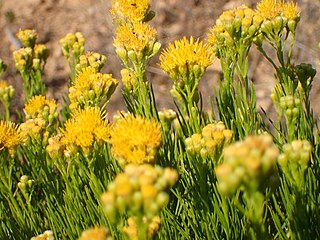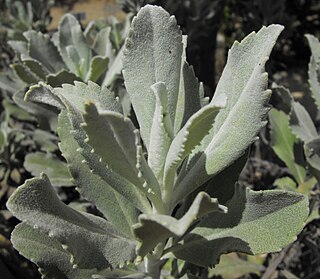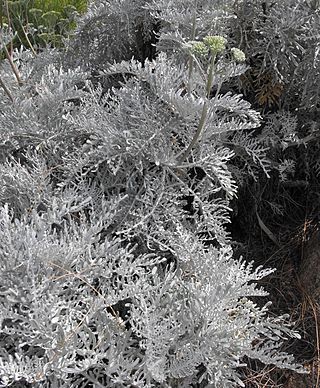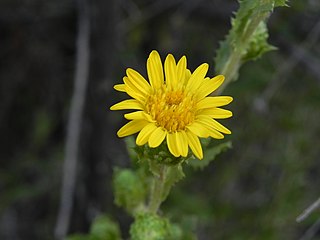
Eriophyllum lanatum, with the common names common woolly sunflower, Oregon sunshine and golden yarrow, is a common, widespread, North American plant in the family Asteraceae.

Juniperus californica, the California juniper, is a species of juniper native to southwestern North America.

Hazardia is a small genus of North American flowering plants in the family Asteraceae. Plants in this genus may be called bristleweeds or goldenbushes.

Ericameria arborescens is a North American species of flowering plants in the family Asteraceae known by the common name goldenfleece. It is widespread across much of California and found also in southwestern Oregon.

Eriophyllum confertiflorum, commonly called golden yarrow or yellow yarrow, is a North American species of plant in the family Asteraceae, native to California and Baja California. It has wooly leaves when young, and yellow flower heads. "Eriophyllum" means "wooly leaved."

Hazardia detonsa is a rare species of shrub in the family Asteraceae known by the common name island bristleweed. It is endemic to the Channel Islands of California, having been found on 4 islands.

Hazardia squarrosa is a North American species of shrub in the family Asteraceae known by the common name sawtooth goldenbush. It is native to California in the United States and Baja California in Mexico.

Helianthella californica is a species of flowering plant in the family Asteraceae known by the common name California helianthella. This wildflower is native to the mountains of California, northwestern Nevada, and southwestern Oregon.

Brickellia californica, known by the common name California brickellbush, is a species of flowering plant in the family Asteraceae.

Artemisia palmeri is a rare species of sagebrush known by the common names San Diego sagewort and Palmer sagewort.
Ericameria brachylepis is a North American species of flowering shrub in the family Asteraceae known by the common names chaparral goldenbush and boundary goldenbush.

Ericameria greenei is a species of flowering shrub in the family Asteraceae known by the common name Greene's goldenbush. It is native to the mountains of the western United States in Washington, Idaho, Oregon, and the northern California as far south as Lake and Tuolumne Counties.

Constancea is a monotypic genus of flowering plants in the family Asteraceae containing the single species Constancea nevinii, which is known by the common name Nevin's woolly sunflower. It is endemic to three of the Channel Islands of California, where it grows in coastal scrub habitat. This is a small shrub or subshrub generally growing up to one or 1.5 meters tall, and taller when an erect form, with a branching, woolly stem. The whitish, woolly oval leaves may be up to 20 centimeters long and are divided into many narrow lobes with edges curled under. The inflorescence is a cluster of 10 to 50 or more small flower heads, each on a short peduncle. The flower head has a center of hairy, glandular, star-shaped yellow disc florets and a fringe of four to nine yellow ray florets, each about 2 millimeters long. The fruit is an achene a few millimeters long with a small pappus at the tip.
Munzothamnus is a monotypic genus of flowering plants in the family Asteraceae containing the single species Munzothamnus blairii, which is known by the common name Blair's wirelettuce, or Blair's munzothamnus. It is endemic to San Clemente Island, one of the Channel Islands of California. It grows along steep, rocky cliffsides and canyons on the island. It is a shrub producing a fleshy, woolly stem usually over a meter in height, often approaching two meters. Leaves occur in tufts at the ends of the stem branches. They are up to 15 centimeters long, oblong in shape, and sometimes very shallowly lobed. They are woolly when new but lose their hairs and become shiny green with age. The inflorescence is a large array of up to 35 flower heads. Each head has a cylindrical base under a centimetre long and contains 9 to 12 light lavender or pinkish flowers. Each flower is a ray floret with an erect tube and a strap-shaped ligule with a toothed tip. The ligule is just under a centimetre long. The fruit is a cylindrical, ribbed achene with a white pappus.

Agoseris heterophylla is a liguliferous species in the family Asteraceae known by the common name annual agoseris or mountain dandelion. It is widespread in mostly drier regions of western North America from British Columbia to Baja California.

Senecio lyonii is an uncommon species of flowering plant in the aster family known by the common name island senecio. This island endemic is known only from Guadalupe Island off the coast of Baja California and two of the Channel Islands of California, Catalina and San Clemente Islands. It grows in the coastal sage scrub and chaparral of the islands' hills and canyons. It is a shrub or subshrub growing from a woody taproot and reaching top heights well over one meter. The leaves have blades up to 12 centimeters long which are divided deeply into many narrow lobes. The inflorescence is made up of many clusters of flower heads. Each head has narrow phyllaries usually tipped with black, yellow disc florets and a fringe of yellow ray florets each about a centimeter long.
Hazardia orcuttii is a rare North American species of flowering plant in the family Asteraceae known by the common names Orcutt's bristleweed and Orcutt's goldenbush. It is native to California in the United States and Baja California in Mexico. It can be found in one location in California, in the city of Encinitas. There, it is located in and near a protected zone known as the Manchester Conservation Area. In Baja California it can be found at 11 to 17 locations.
Ericameria albida is a North American species of flowering shrub in the family Asteraceae known by the common name white flowered rabbitbrush. It is native to desert regions in the western United States mostly in the Great Basin (Utah, Nevada, and eastern California.

Ericameria parishii, or Parish's rabbitbrush, is a western North American species of flowering plants in the family Asteraceae.

Hazardia berberidis is a species of flowering plant in the family Asteraceae commonly known as the barberry-leaf goldenbush. A woody shrub, it is characterized by sawtooth leaves and yellow ray flowers that bloom from March to August. It is endemic to the coastal sage scrub and coastal succulent scrub habitats of Baja California, Mexico, but with populations of uncertain origin in San Diego County, California.















